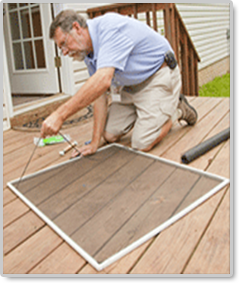The Best Way to Clean Window Screens

Window screens allow cool, fresh air to come in while keeping bugs out . . . but of course, you also want to see out of them. This article describes the best way to clean your window screens.
To get started, you will want to fill a good-size pail with warm water and a few drops of dish soap, and then find a soft-bristled hand brush and some lint-free hand towels. If you are taking the screens down for the first time, you will probably want to use a Sharpie permanent marker to write some notes on the screen frames, so that you know exactly where to put each screen back.
You can begin cleaning your screen with it either standing up or you can lay it down flat on a deck or in your lawn. If your screens are very dusty, you should first remove the dirt and dust using a shop vac, vacuum upholstery attachment, or dry rag (see costs and reviews of shop vacs). Then dip your brush in the soapy water, and gently scrub each side of the screen. To remove the soap residue, gently spray the screen with a hose before the soap film has time to dry.
Next, you will want to remove the water from the screen. To do this, it is important to first identify the front from the back of the screen. The back of the screen will have a rubber cord around the frame, which is there to hold the screen to the frame. While facing the back of the screen, you will want to GENTLY slap the screen with a clean lint-free towel, which will dislodge the water trapped in the mesh of the screen (see costs and reviews of lint-free towels). Do NOT slap the screen on the front side, as this can cause the screen to pop out of the cord that is holding it to the frame. After the water is removed from the screen, wipe down the frame with your towel. Your screen is now ready to be put back into its place on your window.
To get started, you will want to fill a good-size pail with warm water and a few drops of dish soap, and then find a soft-bristled hand brush and some lint-free hand towels. If you are taking the screens down for the first time, you will probably want to use a Sharpie permanent marker to write some notes on the screen frames, so that you know exactly where to put each screen back.
You can begin cleaning your screen with it either standing up or you can lay it down flat on a deck or in your lawn. If your screens are very dusty, you should first remove the dirt and dust using a shop vac, vacuum upholstery attachment, or dry rag (see costs and reviews of shop vacs). Then dip your brush in the soapy water, and gently scrub each side of the screen. To remove the soap residue, gently spray the screen with a hose before the soap film has time to dry.
Next, you will want to remove the water from the screen. To do this, it is important to first identify the front from the back of the screen. The back of the screen will have a rubber cord around the frame, which is there to hold the screen to the frame. While facing the back of the screen, you will want to GENTLY slap the screen with a clean lint-free towel, which will dislodge the water trapped in the mesh of the screen (see costs and reviews of lint-free towels). Do NOT slap the screen on the front side, as this can cause the screen to pop out of the cord that is holding it to the frame. After the water is removed from the screen, wipe down the frame with your towel. Your screen is now ready to be put back into its place on your window.
Related Articles . . .
Tips for Better and Easier Window Washing
When your windows are clean, you get a crystal-clear view of a beautiful day. Here are some tips that will help you make your window washing go faster and much better, and will give you truly professional results.
Storm Window Care
Your storm windows are great for reducing your energy bills by providing an extra layer of insulation which reduces heat transfer from your home. This article gives you advice on how to best take care of your storm windows.
Making Window Cleaning Fun for Kids
If you have kids, this article gives you some fun ideas for getting them involved in your window cleanings.


